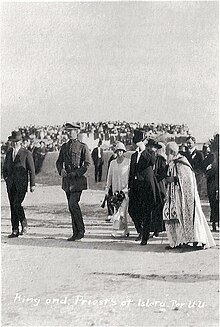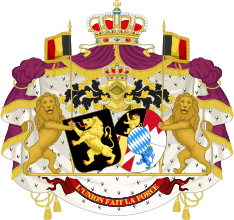Elisabeth of Bavaria, Queen of the Belgians
You can help expand this article with text translated from the corresponding article in French. (May 2021) Click [show] for important translation instructions.
|
| Elisabeth of Bavaria | |||||
|---|---|---|---|---|---|
Kingdom of Belgium | |||||
| Burial | |||||
| Spouse | |||||
| Issue | |||||
| |||||
Infanta Maria José of Portugal | |||||
Elisabeth of Bavaria (Elisabeth Gabriele Valérie Marie; 25 July 1876 – 23 November 1965) was
Family
She was born in
An artist himself, Duke Karl-Theodor cultivated the artistic tastes of his family and Elisabeth was raised with a deep love for painting, music and sculpture. At her father's clinic, where her mother assisted him as a nurse, Elisabeth obtained exposure to productive labor and to human suffering, unusual for a princess of that time.
Married life and queenship
This section needs additional citations for verification. (August 2020) |

In Munich on 2 October 1900, Duchess Elisabeth married Prince Albert I, second-in-line to the throne of Belgium (after his father Prince Philippe, Count of Flanders). Upon her husband's accession to the Belgian throne in 1909, Elisabeth became queen. The Congolese city of Élisabethville, today Lubumbashi, was named in her honor.
They first met in 1897 at the funeral of Elisabeth's aunt Duchess Sophie Charlotte in Bavaria, who was also the mother-in-law of Albert's sister Henriette. At the time, Prince Albert was the heir to his uncle Leopold II of Belgium. Albert was the second son of Prince Philippe, Count of Flanders, and Princess Marie of Hohenzollern-Sigmaringen, a sister of King Carol I of Romania.
At birth, Albert occupied the third place in the line of succession behind his father and elder brother,

In December 1909, Albert and Elisabeth became King and Queen of the Belgians, following the death of Albert's uncle, King Leopold II. The new Queen took on a much more public role than her predecessors, getting involved with many charities and organizations, particularly those in the arts and social welfare. She often surrounded herself with famous authors and artists, as well as leading scientists of the day. Her friendly nature, and true care and concern for others, quickly endeared her to the people of Belgium.
When war broke out in 1914, Queen Elisabeth worked with the nurses on the front and helped establish the Symphony Orchestra of the field army. By the end of 1914, she gave Belgian King's Messenger Archibald A. Gordon alias Major Gordon the task to participate in the establishment of the Hospital L'Océan in La Panne. The Queen traveled frequently to the United Kingdom, under the pretext of visiting her children who were studying there. She was often bringing important messages and information to the British government from her husband and his forces. Following the war, the family made a triumphant return to Brussels and set about to rebuild the nation.
During the

From 23 September to 13 November 1919, the Queen, together with the King and
Later years
On 17 February 1934, Albert I died in a mountain climbing accident in the
Elisabeth lived to see her son become king (but also go into exile and abdicate), her younger son become, effectively, regent of the realm, and her grandson mount the throne.
| Righteous Among the Nations |
|---|
 |
| By country |
As queen dowager, she became a patron of the arts and was known for her friendship with such notable scientists as Albert Einstein.[citation needed]
During the
During the 1950s, the Queen evoked controversy abroad by visiting the
Death
Queen Elisabeth died in Brussels at the age of 89 on 23 November 1965 from a heart attack. She is interred in the royal vault at the Church of Our Lady of Laeken, Brussels. She was the 1,016th Dame of the Royal Order of Queen Maria Luisa.
Legacy
The city of Lubumbashi in Congo (Kinshasa) was formerly known as "Élisabethville", and it was named in her honor when it was founded in 1910 in what was then the Belgian Congo. It adopted its current name in 1966 when, after six years of wrangling following independence, Joseph Desire Mobutu ordered Belgian place names in Congo changed.
The Queen Elisabeth Competition, a longstanding international competition for career-starting classical musicians regularly held in Brussels, is named after her.[7]
Belgian Egyptologist Jean Capart created the Fondation Égyptologique Reine Élisabeth in honor of her visit to Tutankhamun's tomb on 18 February 1923.[8] The association is now called Association Égyptologique Reine Élisabeth.
Children
- King Leopold III of Belgium, born 3 November 1901, and died at Woluwe-Saint-Lambert on 25 September 1983.
- Prince Charles, Count of Flanders, born Brussels 10 October 1903, and died at Ostend on 1 June 1983.
- Thonex, Switzerland, on 27 January 2001.
Honours

National
 Bavarian Royal Family: Dame of the Royal Order of Saint Elizabeth, 1st Class
Bavarian Royal Family: Dame of the Royal Order of Saint Elizabeth, 1st Class Belgium: Knight Grand Cross of the Order of Leopold I
Belgium: Knight Grand Cross of the Order of Leopold I
Foreign
 Austrian Imperial and Royal Family: Dame Grand Cross of the Imperial Austrian Order of Elisabeth, 1910[9]
Austrian Imperial and Royal Family: Dame Grand Cross of the Imperial Austrian Order of Elisabeth, 1910[9] France: Grand Cross of the Order of the Legion of Honour, 14 November 1918[10][11]
France: Grand Cross of the Order of the Legion of Honour, 14 November 1918[10][11] Empire of Japan: Dame Grand Cordon of the Order of the Precious Crown
Empire of Japan: Dame Grand Cordon of the Order of the Precious Crown Luxembourg: Dame of the Order of the Gold Lion of the House of Nassau
Luxembourg: Dame of the Order of the Gold Lion of the House of Nassau Netherlands:
Netherlands:
- Dame Grand Cross of the Order of the Lion of the Netherlands
- Queen Juliana Inauguration Medal
 Poland:
Poland:
- Grand Cross of the Order of the White Eagle[12]
- Cross of Valour Medal, 1922[13]
- Spanish Royal Family: Dame of the Order of Queen Maria Luisa, 24 June 1910[14]
 United Kingdom: Member of the Decoration of the Royal Red Cross
United Kingdom: Member of the Decoration of the Royal Red Cross Holy See: Dame of the Decoration of Honour
Holy See: Dame of the Decoration of Honour
- Awards
 International Red Cross and Red Crescent: Recipient of the Florence Nightingale Medal
International Red Cross and Red Crescent: Recipient of the Florence Nightingale Medal- Yad Vashem Righteous Among the Nations
Arms
-
Alliance Coat of Arms of King Albert I
and Queen Elisabeth -
Royal Monogram of Queen Elisabeth
of Belgium
Ancestry
| Ancestors of Elisabeth of Bavaria, Queen of the Belgians | |||||||||||||||||||||||||||||||||||||||||||||||||
|---|---|---|---|---|---|---|---|---|---|---|---|---|---|---|---|---|---|---|---|---|---|---|---|---|---|---|---|---|---|---|---|---|---|---|---|---|---|---|---|---|---|---|---|---|---|---|---|---|---|
| |||||||||||||||||||||||||||||||||||||||||||||||||
See also
References
- ISBN 978-0-86534-714-4
- ^ W.A. Keleher. The Indian sentinel.1920, vol.2. p.23-24
- Holocaust, at Yad Vashemwebsite
- ^ p.70, Horrocks, Brian, Belfield, Eversley, Essame, H., Corps Commander, Magnum Books, London, 1977
- ISBN 978-0-19-923968-9.
- ^ "Queen Mother Elizabeth of Belgium Goes to Israel; First Royal Visit". March 23, 1959.
- ^ "Queen Elisabeth Competition: History:1900". cmireb.be. Retrieved 7 December 2019.
- ^ "Association Égyptologique Reine Élisabeth". aere-egke.be. Retrieved 2 August 2022.
- ^ "Elisabeth-orden", Hof- und Staatshandbuch der Österreichisch-Ungarischen Monarchie, Vienna: Druck und Verlag der K.K. Hof- und Staatsdruckerei, 1912, p. 225
- ISBN 978-2-35077-135-9.
- ^ "Hommage de la République française à la Cité liégeoise". Liège (in French). Archived from the original on 19 April 2015. Retrieved 17 October 2018.
- ^ Kawalerowie i statuty Orderu Orła Białego 1705-2008, 2008, s. 300
- ^ Dziennik Personalny M.S.Wojsk. Nr 13 z 8.06.1922 r.
- ^ "Real orden de Damas Nobles de la Reina Maria Luisa". Guía Oficial de España (in Spanish). 1928. p. 236. Retrieved 9 May 2020.
External links
 Media related to Queen Elisabeth of Belgium at Wikimedia Commons
Media related to Queen Elisabeth of Belgium at Wikimedia Commons- Newspaper clippings about Elisabeth of Bavaria, Queen of the Belgians in the 20th Century Press Archives of the ZBW
- Portraits of Elisabeth of Bavaria, Queen of the Belgians at the National Portrait Gallery, London


